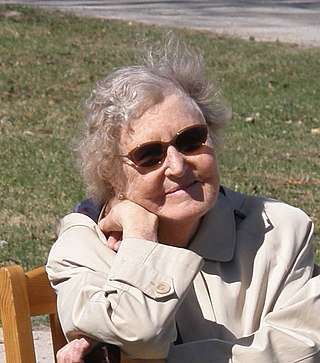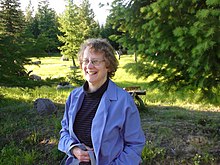
A creole language, or simply creole, is a stable natural language that develops from the process of different languages simplifying and mixing into a new form, and then that form expanding and elaborating into a full-fledged language with native speakers, all within a fairly brief period of time. While the concept is similar to that of a mixed or hybrid language, creoles are often characterized by a tendency to systematize their inherited grammar. Like any language, creoles are characterized by a consistent system of grammar, possess large stable vocabularies, and are acquired by children as their native language. These three features distinguish a creole language from a pidgin. Creolistics, or creology, is the study of creole languages and, as such, is a subfield of linguistics. Someone who engages in this study is called a creolist.
The Middle English creole hypothesis is a proposal that Middle English was a creole, which is usually defined as a language that develops during contact between two groups speaking different languages and that loses much of the grammatical elaboration of its source languages in the process. The vast differences between Old English and Middle English, and English’s status as one of the least structurally elaborated of the Germanic languages, have led some historical linguists to argue that the language underwent creolisation at around the 11th century, shortly after the Norman conquest of England. Other linguists suggest that creolisation began earlier, during the Scandinavian incursions of the 9th and 10th centuries.

The Salishan languages are a family of languages of the Pacific Northwest in North America. They are characterised by agglutinativity and syllabic consonants. For instance the Nuxalk word clhp’xwlhtlhplhhskwts’, meaning "he had had [in his possession] a bunchberry plant", has twelve obstruent consonants in a row with no phonetic or phonemic vowels.

Xenoglossy, also written xenoglossia and sometimes also known as xenolalia, is the supposedly paranormal phenomenon in which a person is allegedly able to speak, write or understand a foreign language that they could not have acquired by natural means. The term derives from the Ancient Greek xenos (ξένος), "foreigner" and glōssa (γλῶσσα), "tongue" or "language". The term xenoglossy was first used by French parapsychologist Charles Richet in 1905. Accounts of xenoglossy are found in the New Testament, and contemporary claims have been made by parapsychologists and reincarnation researchers such as Ian Stevenson. Doubts have been expressed that xenoglossy is an actual phenomenon, and there is no scientifically admissible evidence supporting any of the alleged instances of xenoglossy.
Language contact occurs when speakers of two or more languages or varieties interact with and influence each other. The study of language contact is called contact linguistics. Language contact can occur at language borders, between adstratum languages, or as the result of migration, with an intrusive language acting as either a superstratum or a substratum.
A mixed language, also referred to as a hybrid language, contact language, or fusion language, is a language that arises among a bilingual group combining aspects of two or more languages but not clearly deriving primarily from any single language. It differs from a creole or pidgin language in that, whereas creoles/pidgins arise where speakers of many languages acquire a common language, a mixed language typically arises in a population that is fluent in both of the source languages.
Robert Hale Ives Goddard III is a linguist and a curator emeritus in the Department of Anthropology of the National Museum of Natural History at the Smithsonian Institution. He is widely considered the leading expert on the Algonquian languages and the larger Algic language family.
Salikoko Mufwene is a linguist born in Mbaya-Lareme in the Democratic Republic of the Congo. He is the Edward Carson Waller Distinguished Service Professor of linguistics at the University of Chicago. Mufwene was elected to the American Philosophical Society in 2022.
Terrence Kaufman was an American linguist specializing in documentation of unwritten languages, lexicography, Mesoamerican historical linguistics and language contact phenomena. He was an emeritus professor of linguistics and anthropology at the University of Pittsburgh.

Shana Poplack, is a Distinguished University Professor in the linguistics department of the University of Ottawa and three time holder of the Canada Research Chair in Linguistics. She is a leading proponent of variation theory, the approach to language science pioneered by William Labov. She has extended the methodology and theory of this field into bilingual speech patterns, the prescription-praxis dialectic in the co-evolution of standard and non-standard languages, and the comparative reconstruction of ancestral speech varieties, including African American vernacular English. She founded and directs the University of Ottawa Sociolinguistics Laboratory.

The Salish or Séliš language, also known as Kalispel–Pend d'oreille, Kalispel–Spokane–Flathead, or Montana Salish to distinguish it from other Salishan languages, is a Salishan language spoken by about 64 elders of the Flathead Nation in north central Montana and of the Kalispel Indian Reservation in northeastern Washington state, and by another 50 elders of the Spokane Indian Reservation of Washington. As of 2012, Salish is "critically endangered" in Montana and Idaho according to UNESCO.

Ilse Lehiste was an Estonian-born American linguist, author of many studies in phonetics.
Gillian Elizabeth Sankoff is a Canadian-American sociolinguist, and professor emerita of linguistics at the University of Pennsylvania. Sankoff's notable former students include Miriam Meyerhoff.
Anne Harper Charity Hudley is an American linguist who works on language variation in secondary schools. Since 2021, she has been a professor at the Stanford Graduate School of Education.

Alice Carmichael Harris is an American linguist. She is Professor emerita of Linguistics at the University of Massachusetts Amherst.
Maria “Masha” Polinsky is an American linguist specializing in theoretical syntax and study of heritage languages.
Megan Jane Crowhurst is an Australian- and Canadian-raised linguist and Professor of Linguistics at the University of Texas at Austin in the United States.
Lenore A. Grenoble is an American linguist specializing in Slavic and Arctic Indigenous languages. She is currently the John Matthews Manly Distinguished Service Professor and chair at University of Chicago.
Ceil (Kovac) Lucas is an American linguist and a professor emerita of Gallaudet University, best known for her research on American Sign Language.
Marlyse Baptista is a linguist specializing in morphology, syntax, pidgin and creole languages, language contact, and language documentation. She is currently Uriel Weinreich Collegiate Professor of Linguistics at the University of Michigan.







